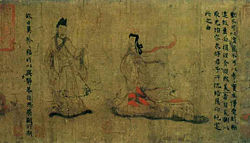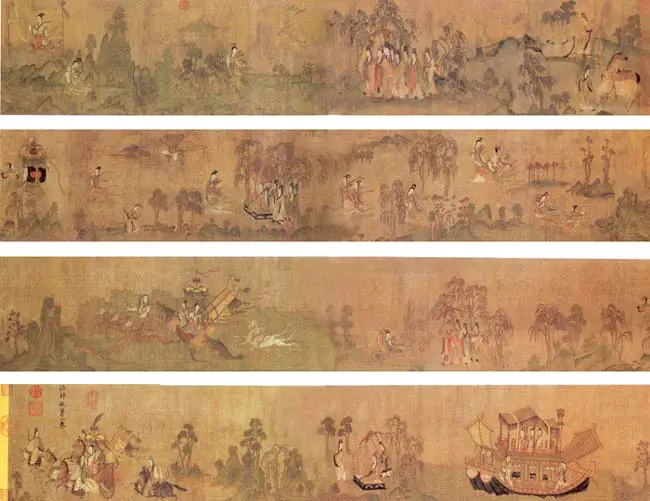Difference between revisions of "Gu Kaizhi" - New World Encyclopedia
Keisuke Noda (talk | contribs) (import from wiki) |
Keisuke Noda (talk | contribs) |
||
| Line 15: | Line 15: | ||
==''Wise and Benevolent Women''== | ==''Wise and Benevolent Women''== | ||
Little scholarship on this painting seems to exist in English. | Little scholarship on this painting seems to exist in English. | ||
| − | + | [[Image:Goddess of luo shui.jpg|thumb|center|1000px|Goddess of luo shui, 洛神賦図]] | |
==External links== | ==External links== | ||
{{commons}} | {{commons}} | ||
Revision as of 14:21, 27 July 2007
Gu Kaizhi (Traditional Chinese: 顧愷之; Simplified Chinese: 顾恺之; Hanyu Pinyin: Gù Kǎizhī; Wade-Giles: Ku K'ai-chih) (ca. 344-406), is a celebrated painter of ancient China. According to historical records he was born in Wuxi, Jiangsu province and first painted at Nanjing in 364. In 366 he became an officer (Da Sima Canjun, 大司马参军). Later he was promoted to royal officer (Sanji Changshi, 散骑常侍). He was also a talented poet and calligrapher. He wrote three books about painting theory: On Painting (画论), Introduction of Famous Paintings of Wei and Jin Dynasties (魏晋胜流画赞) and Painting Yuntai Mountain (画云台山记). He wrote: "In figure paintings the clothes and the appearances were not very important. The eyes were the spirit and the decisive factor."
Gu's art is known today through copies of three silk handscroll paintings attributed to him.
Admonitions of the Instructress to the Palace Ladies
This painting - probably a Tang dynasty copy - illustrates nine stories from a political satire about Empress Jia (賈后) written by Zhang Hua (张华 ca. 232-302). Beginning in the eighth century, many collectors and emperors left seals, poems, and comments on the scroll. The Admonitions scroll was stored in the emperor's treasure until it was looted by the British army in the Boxer Uprising in 1900. Now it is in the British Museum collection, missing the first two scenes. Restoration specialists working on the scroll used the wrong materials and caused it to become brittle, so it can only be displayed flat. The original copy is a horizontal handscroll, painted by ink and color on silk.
Nymph of the Luo River (洛神赋)
Nymph of the Luo River survives in three copies dating to the Song dynasty. It illustrates a poem written by Cao Zhi (曹植 192-232). One copy is held by the Palace Museum of Beijing; another is at the Freer Gallery in Washington, D.C. The third was brought to Manchu by the last emperor Pu Yi (溥仪 1906-1967) while he was the puppet emperor of Manchukuo under Japanese rule. When the Japanese surrendered in 1945 the painting disappeared. After ten years the Liaoning provincial museum recovered it.
Wise and Benevolent Women
Little scholarship on this painting seems to exist in English.
External links
zh-classical:顧愷之
Credits
New World Encyclopedia writers and editors rewrote and completed the Wikipedia article in accordance with New World Encyclopedia standards. This article abides by terms of the Creative Commons CC-by-sa 3.0 License (CC-by-sa), which may be used and disseminated with proper attribution. Credit is due under the terms of this license that can reference both the New World Encyclopedia contributors and the selfless volunteer contributors of the Wikimedia Foundation. To cite this article click here for a list of acceptable citing formats.The history of earlier contributions by wikipedians is accessible to researchers here:
The history of this article since it was imported to New World Encyclopedia:
Note: Some restrictions may apply to use of individual images which are separately licensed.



